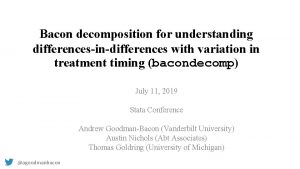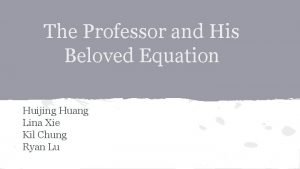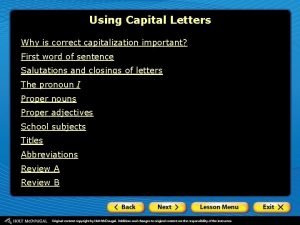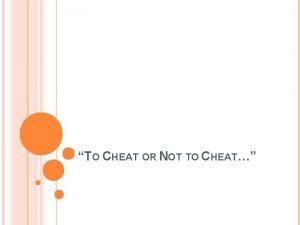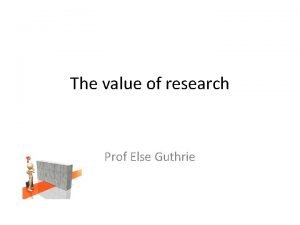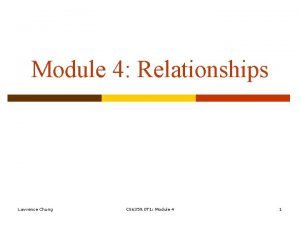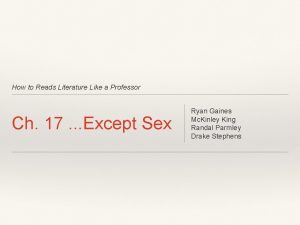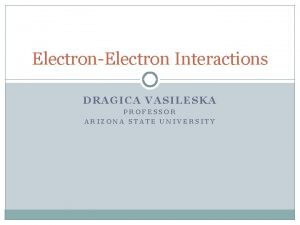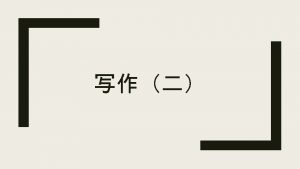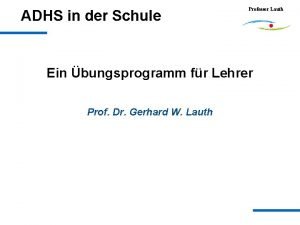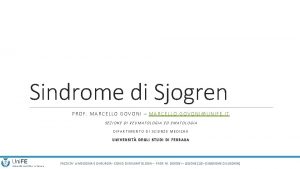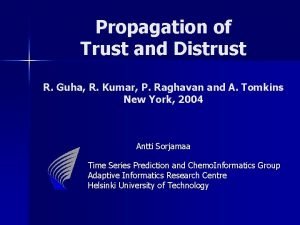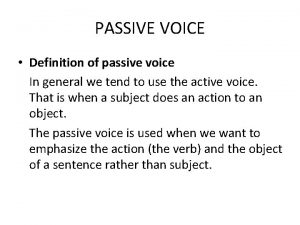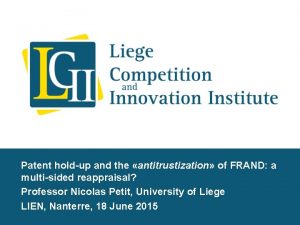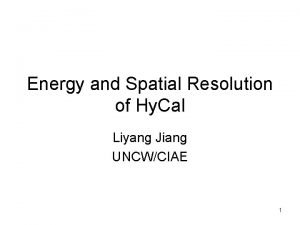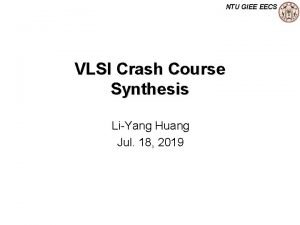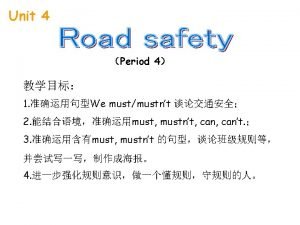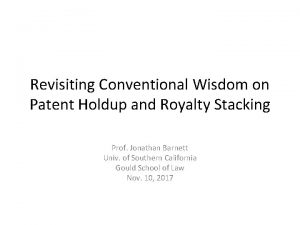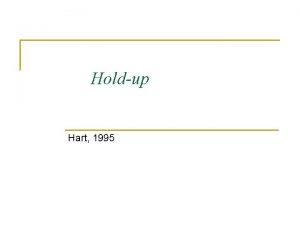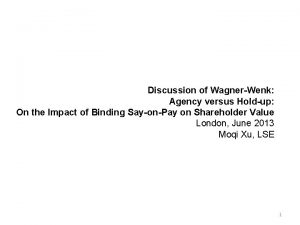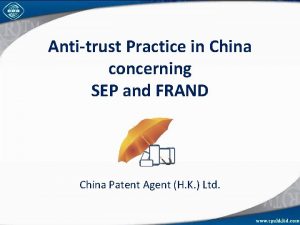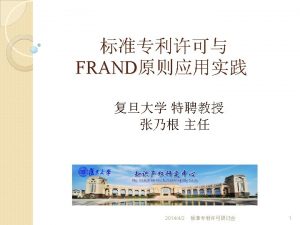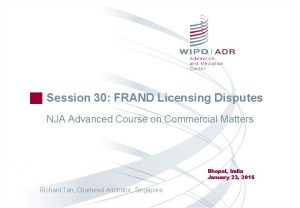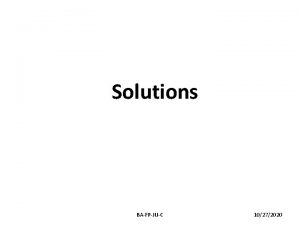FRAND Holdup and Its Solutions Liyang Professor of



























































- Slides: 59

FRAND Holdup and Its Solutions Liyang , Professor of Sun Yat. Sen University School of Law

Aim • Standardization of patent may lead to patent holdup and royalty stacking. However, uncertainty and ambiguity of FRAND provided by SSOs to be used for mitigating patent holdup and royalty stacking and one-sided denial of injunction against standard essential patent(SEP) implementer has resulted in FRAND holdup and excessively low royalty, the interest balance between SEP holder and SEP implementer has been broken by FRAND holdup. A new balance mechanism must be found to effectively protect patent rights and fully promote utilization of patented technologies.

My Research Questions FRAND Holdup and Its Solutions Focus on the following often neglected issues: 1. The reasons why FRAND holdup happen? 2. Under what circumstances can SEP holder seek injunction relief to avoid FRAND holdup? • 3. Should SEP holder disclose the comparable royalties to SEP implementer to avoid FRAND holdup? • 4. What kind of rules should be designed to judge whether SEP implementer does FRAND holdup or not? • 5. What kind of rules should be designed to prevent FRAND holdup(and patent holdup)? • •

A Few Important Findings • 1. The risks of patent holdup and royalty stacking have been grossly exaggerated. • 2. FRAND holdup has become an issue extremely perplexing SEP holder. • 3. It’s almost impossible for different jurisdictions to find substantive FRAND royalty.

• 4. In some circumstances, it’s necessary for SEP holder to seek injunction relief in order to avoid FRAND holdup. • 5. To prevent FRAND holdup and mitigate patent holdup, SEP holder should disclose the comparable royalties to SEP implementer. • Therefore , my research provides an explanation why FRAND holdup happens, and designs a set of rule to avoid FRAND holdup and to mitigate patent holdup in the meantime.

Outline of Presentation • • • • I. Background 1. Standardization of Patent (1) To facilitate interoperability of different manufacturers’ products and increase price competition. (2)To decrease comsumer’s switching cost. (3)To promote utilization of patented technology. 2. SSOs and intellectual property rights policy II. The risks of patent holdup and FRAND holdup 1. What’s patent holdup and FRAND holdup 2. The risks of patent holdup and FRAND holdup III. The reasons why FRAND holdup happen. 1. The risks of patent holdup is grossly exaggerated. 2. The uncertainty and ambiguity of FRAND 3. One-sided denial of injunction 4. The information asymmetry

• IV. Solutions to FRAND holdup(and patent holdup at the meantime) • 1. Unavoidableness of patent holdup and FRAND holdup • 2. Four tasks of any possible solutions. • (1)to solve the possibility of injunction • (2)to solve disclosure of the comparable royalties. • (3)to stimulate SEP holder and SEP implementer to successfully negotiate FRAND royalty as possible. • (4)to provide guideline for court to decide FRAND royalty in case of negotiation failure.

• 3. A comment on CJEU’s newest judgement(Huawei v. ZTE. Case C-170/13). • (1)The core of the judgement • (2)comment 4. Rule of Notice and Counter-Notice • (1)SEP holder’s Notice • (2)SEP implementer’s counter-Notice • (3) Consequences against the rule of Notice and Counter-Notice • V. Conclusion

I. Background • 1. Standardization of Patent • (1) To facilitate interoperability of different manufacturers’ products and increase price competition. • (2)To decrease comsumer’s switching cost. • (3)To promote utilization of patented technology. • 2. SSOs and intellectual property Rights policy

• ETSI: 6. 1: When an ESSENTIAL IPR relating to a particular STANDARD or TECHNICAL SPECIFICATION is brought to the attention of ETSI, the Director. General of ETSI shall immediately request the owner to give within three months an irrevocable undertaking in writing that it is prepared to grant irrevocable licences on fair, reasonable and non-discriminatory (“FRAND”) terms and conditions under such IPR to at least the following extent: • MANUFACTURE, including the right to make or have made customized components and sub-systems to the licensee's own design for use in MANUFACTURE; sell, lease, or otherwise dispose of EQUIPMENT so MANUFACTURED; repair, use, or operate EQUIPMENT; and use METHODS. • The above undertaking may be made subject to the condition that those who seek licences agree to reciprocate.

II. The risks of patent holdup and FRAND holdup • 1. What’s patent holdup and FRAND holdup • Patent holdup means a SEP holder unreasonably exercises its SEP rights with FRAND commitments to obtain excessively high royalties. • FRAND holdup means a SEP implementer strategically and unreasonably deploys uncertainty and ambiguity of FRAND to pay excessively low royalties or even not to pay any royalties to a SEP holder. • FRAND holdup is often called reverse holdup. However, because the uncertainty and ambiguity of FRAND are one of the most important reasons why reverse holdup take place, this paper calls reverse holdup as “FRAND holdup”. • (Case C-170/13, I-8(Huawei Technologies Co. Ltd v. ZTC Corp. and ZTC Deutschland Gmb. H).

• 2. The risks of patent holdup and FRAND holdup (1)The risks of patent holdup: To hinder utilization of SEP and damage consumer’s welfare. (i)“enables a holder of an SEP to demand more than the value of its patented technology and to attempt to capture the value of the standard itself…The threat of holdup increases as the standard becomes more widely implemented and firms make sunk cost investments that cannot be recovered if they are forced to forego implementation of the standard or the standard is charged. • (ii)Holdup can threaten the diffusion of valuable standards and undermine the standard-setting process…

• (iii)holdup also harms consumers to the extent that those excess costs are passed onto them. • (iv)Holdup by one SEP holder also harms other firms that hold SEPs relating to the same standard because it jeopardizes further adoption of the standard and limits the ability of those other holders to obtain appropriate royalties on their technology. ” • [Microsoft Corp. v. Motorola, Inc. , Order 2122, 2013 U. S. Dist. LEXIS 60233(W. D. Wash. Apr. 25, 2013)]

• (2)The risks of FRAND holdup: To hinder innovation and damage consumer’s welfare. • (i)“could make innovators active in standardized fields face significant risks of being undercompensated and thus become the victims of reverse holdups. ” [Dimien Geradin, Reverse Holdup: The(Often Ignored)Risks Faced by Innovators in Standardized Areas. SSRN Electronic Journal 11/2010; Dol: 10. 2139/ssrn. 1711744] • (ii)an implementer’s best strategy would be to infringe the SEPs and litigate FRAND terms, delaying the execution of a licensing agreement and • (iii)burdening the courts and • (iv) diminishing the incentives for an SEP holder to contribute future technologies to the standard in the meantime. ” • [Gregory Sidak, the Meaning of FRAND, Part II: Injunctions, Journal of Competition Law and Economics, 11(1), at 268 -269. ]

III. The reasons why FRAND holdup happen. • 1. The risks of patent holdup is grossly exaggerated. • (i)“no empirical evidence that any industry standard has been significantly harmed by ‘holdup’. ” • [Damien Geradin, Reverse Holdups: The(Often Ignored)Risks Faced by Innovators in Standardized Areas. ]

• (ii)“The patent holdup is theoretically possible but rarely occurs in practice. ” • [Commissioner Joshua Wright of FTC observed in 2013 that, depite the amount of attention patent holdup has drawn from policymakers and academics, there have been relatively few instances of litigated patent holdup among the thousands adopted and empirical evidence of patent holdup is unremarkable. Josha D. Wright, Comm’r, Fed. Trade Comm’n, Remarks at the Center for the Protection of Intellectual Property Inaugural Academic Conference: The Commercial Function of Patents in Today’s Innovation Economy 20(Sept. 12, 2013). http: //cpip. gmu. edu/wpcontent/uploads/2013/06/Program-Schedule. pdf. ]

• (iii)holdup is unlikely when SEP implementer believes in any time that the licensing royalty offered by SEP holder is against FRAND and exercises the right to challenge the offered licensing terms. • [Dennis W. Carlton and Allan Shampine, Identifying Benchmarks for Applying Non-Discrimination in FRAND, 8 Competition POL’INT’L 1, 5(2014). ]

• (iv)even if patent holdup could arise, there is no reason to assume the SEP holder will use injunction as a tool to hold up infringer. SEP holder can seek injunction for some legitimate purposes, for instance, against an infringer unwilling to pay FRAND royalties, to force SEP implementer to negotiate with it in good faith. • [Gregory Sidak, The Meaning of FRAND, Part II: Injunction, Journal of Competition Law and Economics, 11(1), 2015, at 233 -234. ]

• (v)there is no reason to assert that the royalties negotiated under the threat of injuncition will be beyond FRAND royalties. • [Gregory Sidak, The Meaning of FRAND, Part II: Injunction, Journal of Competition Law and Economics, 11(1), 2015, at 234. ]

• (vi)there is also not empirical data to back the idea that patent holdup has harmed the setting and implementation of standards. • [The World in 2013: ICT Facts and Figures, http: //www. itu. int/en/ITUD/Statistics/Documents/facts/ICTFacts. Figure s 2013 -e. pdf. ]

• Summary: • grossly exaggeration of risks of patent holdup has led to all kinds of proposals explicitly or implicitly designed to prevent and eliminate patent holdup, for example, collective negotiation of royalties, depriving the ability of SEP holder to seek injunctive relief and to reinterpret FRAND as a tool to limit the ability of SEP holder to monetize innovation, have been or being made full use of tactically by SEP implementer to force SEP holder to excessively reduce royaltyies, in another word, reversely hold up SEP holder. [Damien Geradin, Reverse Hold-ups: The(Often Ignored)Risks Faced by Innovators in Standardized Areas. . ] • [Einer Elhauge’s analysis shows that holdup and stacking problems does not bring about systematically excessive royalties, to the contrary, the royalty rates predicted by the holdup models are often below the true optional rate. Further, those predicted royalty rates are overstated because of incorrect assumptions about constant demand, one-shot bargaining, and informational symmetry. Einer Elhauge, Do Patent holdup and Royalty Stacking lead to systematically excessive royalties? Journal of Competition Law and Economics, 4(3), 535 -570. ]

• 2. The uncertainty and ambiguity of FRAND • In order to determine FRAND royalty, IP circle has made a great deal of attempt and put forward many approaches as well. However, • “the actual scope and contours of FRAND licenses have puzzled lawyers, regulators and courts for years, and past efforts at clarification have never been very successful. ” • [ Jorge L. Contreras, The February of FRAND, Mar. 6. 2012, Patently-O Patent Law Blog, at http: www. patentlyo. com/patent/2012. 03. february-of -fraud. html. ]

• (1)The Doctrine of SEP Contribution • The doctrine of SEP contribution includes two specific practices. (i)The first doctrine of SEP contribution was adopted by the judgement of Microsoft v. Motorola. In this judgement, the contribution refered to the contribution of the patent to the technical capabilities of the standard and the contribution of those relevant technological capabilities to the implementer’s products using the standard. • [Microsoft Corp. v. Motorola, Inc. , Order 10, 2013 U. S. Dist. LEXIS 60233(W. D. Wash. Apr. 25, 2013). , Order 40 -41, Order 104. ”With the aforementioned framework for determining a RAND royalty rate set forth, the court conducts a hypothetical negotiation for Motorola’s 802. 11 and H. 264 SEPs. First, the court examines Motorola’s H. 264 and 802. 11 patent portfolios to determine each portfolio’s importance to its respective standard as well as the importance to Microsoft’s product…. To determine a reasonable royalty for Motorola’s H. 264 SEP portfolio, the court provides background on the H. 264 and then examine the importance of Motorola’s patent portfolio to the H. 264 Standard and to Microsoft products using the standard. ””The court now determine the importance of Motorola’s 802. 11 SEPs to both the 802. 11 Standard and to the Microsoft products. ”]

• (ii)The second doctrine of SEP contribution was adopted by the judgement of Apple. Japan v. Sumsung. In this case, the contribution was limited to the contribution of the specific component complying with standard in a terminal product to sale of the terminal product and the rate of SEP in the contribution of the specific component complying with standard in a terminal product to sale of the terminal product. • [平成25年(ネ)第10043号 債務不存在確認請求控 訴事件. http: //www. courts. go. jp/app/files/hanrei_jp/209/08 4209_hanrei. pdf, at 137 -142. ]

• It should be said that determining FRAND royalty through the technical or sales contribution complies with “the proportionate principle ”, but the approach determines FRAND royalty rates by substantively examining the importance of the SEPs to a standard and the importance of the SEPs to the products or sale of the product at issue. Unfortunately, it is very hard and even unlikely to quantify the technical contribution of patent to a standard and to the implementer’s terminal products or sales of the products. [Proportionality principle means that “The size or scope of an IP right ought to be proportional to the value or significance of the work covered by the right”and “an IPR must not confer on its holder leverage or power that is grossly disproportionate to what is deserved in the situation. If an IPR would effectively confer power or control over a much more vast market or set of markets than what is actually deserved, in light of the work covered by the IP right, that right must be limited in some way. ” Robert P. Merges, “Justifying IP”, Harvard University Press, 2011. p 150, p 162. ]

• Even if it’s possible to precisely quantify the technical contribution of patent to a standard and to an implementer’s terminal products or the sales of these products, the method still disregards the patentee’s investment cost, the expected profits , the R&D risks, the litigation cost and the risk of whether the relevant patents could be incorporated within certain standards by SSOs while calculating the royalty, the royalty by estimation is likely in conflict with the FRAND principle. • [Roger G. Brooks, Patent “holdup”, Standards-Setting Organizations, and the FTC’S Campaign Against Innovators, 39 AIPLA Q. J. at 465. ]

• (2)Comparison Approach • This approach was adopted in case Huawei v. IDC by Shenzhen Intermediate People’s Court and Guangdong Higher People’s Court. The two courts all emphasized that , although a SEP holder has different licensing royalty models, under roughly the same transaction terms, the licensor(SEP holder) should grant all licensees license to implement SEPs on roughly the same licensing royalty, otherwise the SEPs licensing royalty is against FRAND. In this case, Huawei and Apple were under the roughly the same transaction terms, the royalty that IDC tried to seek from Huawei should be roughly the same as the royalty it had sought from Apple. • [(2013)No. 305 Yue. Gaofa Minsan Zhongzi. ]

• Although comparison approach is the best way to determine what’s non-discriminatory royalty, it’s not applicable to this case. In the case , a very clear fact was that Apple’s patents from which IDC sought royalty included SEPs and NON-SEPS covering iphone and some future mobile phones in the global market, but Huawei only requested for license of IDC’s Chinese SEPs within China. The Chinese courts made no difference between Apple’s license and Huawei’s license when to employ comparison approach to determine FRAND royalty. • Considering Huawei’s request for IDC’s license, a possibility is that the royalty(0. 019%) exceeded greatly the FRAND royalty that Huawei should have paid to IDC and thus thoroughly violated FRAND principle. As such, the Chinese courts determined a royalty through comparision, but it seems that the royalty has not so much with “SEP” and “FRAND”, it’s only a general licensing royalty.

• A possible result that the uncertainty and ambiguity of FRAND itself may lead to is that SEP implementer • ”is able to shift the risk involved in patent negotiation to the patent holder. There is no risk to the exploiter of the technology in not taking a license before they exhaust their litigation options if the only risk to them for violating the agreement is to pay a FRNAD based royalty or fee. This puts the risk of loss entirely on the side of the patent holder. ” • [Sandra Badin, Mike Renaud and James Wodarski, ”Patent Hold-up or Patent Hold-out? Judege Essex Adds His Voice to the SEP-FRAND Debate. ” http: //www. mintz. com/newsletter/2014/Advisories/409 6 -0714 -NAT-IP/index. html. ]

• 3. One-sided denial of injunction • Seen from existing documents, although vehement debates over whether FRAND commitment-encumbered SEP holder has right to seek injunction still exist, the dominant opinion is to deny FRAND commtiment-encumbered SEP holder’s right of remedy of Injunction(including exclusion order)

• (1)U. S. : ”royalty is adequate compensation ”; ”Waiver of injunction”. • Although the U. S. Supreme Courts in e. Bay v. Merc. Exchange held that whether to grant injunctive relief or not must be tested by traditional equitable four factors, at least from the perspective of practices, in these cases related to FRAND -encumbered SEPs, to deny SEP holder’s injunction relief seems have been a main stream. • The four factors include: (1)the plaintiff has suffered an irreparable injury; (2)remedies available at law, such as monetary damages, are inadequate to compensate for plaintiff’s injury; (3)considering the balance of hardships between the plaintiff and defendant, a remedy in equity is warranted; (4)the public interest would not be disserved by a permanent injunction. e. Bay, Inc. v. Merc. Ecchange, L. L. C. , 547 U. S. 388(266).

• (2)Japan: ”misuse of right” • Sumsung’s claim for injunction prohibiting Apple from infringing Sumsung’s SEPs with FRAND commitments harmed Apple’s interest of reliance on FRAND commitments as a SEP user and thus constituted misuse of right and dismissed Sumsung’s claim for injunction. • 知財高判平成26年・5・26平成25(ネ)10043 債務不存在確認請求控訴事件。

(3)Situations of injunction in China: • (i)Court’s attitude: lack of judgement, unclear. • (ii)SIPO’s position: implied license. • Article 82 of “Notice for Soliciting Public Opinions on the Draft Amendment of Patent Law of the People' s Republic of China”: “A patent right owner, who participates in the national standard making but fails to disclose the standard essential patent owned by it, is deemed to allow the user of the concerned standard to use its patented technologies. … ”

Summary: • keeping patent holder from seeking injunctive relief or exclusion order would be give SEP implementers “a safe haven, where they are free to avoid their own obligations under the[SSO]agreements, can manufacture potentially infringing goods without license or consequence, can seek to invalidate the IPR in question, and yet are free from the risk of remedy under 19 USC 1337. ” • [Sandra Badin, Mike Renaud and James Wodarski, ”Patent Hold-up or Patent Hold-out? Judege Essex Adds His Voice to the SEP-FRAND Debate. ” http: //www. mintz. com/newsletter/2014/Advisories/40960714 -NAT-IP/index. html. ] •

• 4. The information asymmetry • In the process of negotiation of FRAND SEP licensing royalty, SEP holder usually refuses to disclose licensing agreements already concluded with other competitors to the SEP implementer in the name of trade secrets protection. In the lack of comparable licensing royalties, it’s very difficult for SEP implementer to judge whether the royalty offered by SEP holder to it is nondiscriminatory or not.

• Affected by an idea originating from the information asymmetry that goes like “the SEP holder is bound to misuse its dominant positon to excessively extract licensing royalty”, the SEP implementer is always inclined to hold that the SEP holder definitely violates the FRAND principle no matter how much it quotes, and thus negotiates with SEP holder in bad faith to delay or prolong negotiation on purpose or directly files a lawsuit against the SEP holder with a view to relying upon the court ruling to pay the SEP holder as low licensing royalty as possible. Information asymmetry has become a very important reason causing FRAND holdup.

• Summary of Part II: Grossly exaggerating the risks of patent holdup , suspension of FRAND royalty, limiting or eliminating the availability of injunction, and the information asymmtry have resulted in SEP implementer’s opportunistic behavior, FRAND holdup has become a serious issue perplexing SEP holder.

IV. Solutions to FRAND holdup(and patent holdup at the meantime) • 1. Unavoidableness of patent holdup and FRAND holdup • (1)an ex ante unilateral disclosure of a fixed licensing royalty? • In order to deter patent holdup and FRAND holdup and to determine FRAND royalty at the meantime, to require all standard participants unilaterally to disclose an ex ante licensing royalty to all would-be SEP implementers at the time their patents are incorporated into relevant standard by SSOs is perhaps a choice. For the NPEs(Non-Practicing Entities), an ex ante unilateral disclosure of a fixed licensing royalty may be practicable. However, it’s likely to violate market discipline(the price fluctuates with market) to require all SEP holders engaging in manufacturing, selling, using, offering to sell, importing and exporting to unilaterally disclose an ex ante fixed licensing royalty to all potential licensee and thus impracticable.

• (2) Ex ante multilateral licensing negotiations? • Ex ante multilateral licensing negotiations between IP holders and the group of SSO members is often recommended to mitigate patent holdup and FRAND holdup as well. multilateral licensing negotiations are strictly prohibited by many SSOs because it could potentially bring about antitrust liability , increase the costs of participation and hinder the standard-setting process. • [Scott K. Peterson, Patents and Standard-Setting Processes (Apr. 18, 2002 Hr'g R. ) at 9 -10, http: //www. ftc. gov/opp/intellect/020418 scottkpeterson. pdf. ] •

• (3)To depend on the court’s determination? Court is not the market player, it’s very difficult for court to decide a convincing FRAND royalty. Besides, judge may be unfamiliar with SEP.

• (4)Unavoidableness of patent holdup and FRAND holdup • The above situation shows that in most circumstances the determination of FRAND SEP licensing royalty has to depend on bilateral bargaining between SEP holder and SEP implementer. As long as bilateral negotiation is indispensable for determining FRAND licensing royalty, patent holdup and FRAND holdup may unavoidably happen.

2. Four tasks of any possible solutions. (1)to solve the possibility of injunction (2)to realize disclosure of the comparable royalties. (3)to stimulate SEP holder and SEP implementer to successfully negotiate FRAND royalty as possible. • (4)to provide guideline for court to decide FRAND royalty in case of negotiation failure. • A mechanism that can undertake the four tasks at the meantime is perhaps a set of ex ante just rule called as “Notice and Counter-Notice”. • •

• 3. A comment on CJEU’s newest judgement(Huawei v. ZTE. Case C-170/13). • (1)The core of the judgement: • Holds that SEP holder does not abuse its dominant position by bringing an action for infringement seeking an injunction as long as:

• prior to bringing that action, the proprietor has, first, alerted the alleged infringer of the infringement complained about by designating that patent and specifying the way in which it has been infringed, and, secondly, after the alleged infringer has expressed its willingness to conclude a licensing agreement on FRAND terms, presented to that infringer a specific, written offer for a licence on such terms, specifying, in particular, the royalty and the way in which it is to be calculated, and

• where the alleged infringer continues to use the patent in question, the alleged infringer has not diligently responded to that offer, in accordance with recognised commercial practices in the field and in good faith, this being a matter which must be established on the basis of objective factors and which implies, in particular, that there are no delaying tactics.

• (2)comment • (i)comparable royalties? • Although the judgement makes it clear that under what circumstances can the SEP holder seek injunction against SEP implementer, it does not clear these questions whether the SEP holder should disclose the comparable royalties to the SEP implementer, whether the SEP holder should specify the SEPs that SEP implementer is using and the reasons, SEP implementer still can’t judge whether it is discriminated.

• (ii)providing appropriate security? • Where the alleged infringer is using the teaching of the SEP before a licensing agreement has been concluded, it is for that alleged infringer, from the point at which its conter-offer is rejected, to provide appropriate security, in accordance with recognised commercial practices in the field, for example by providing a bank guarantee or by placing the amounts necessary on deposit. • Before FRAND royalty is determined, is it practicable to require SEP implementer to do so? • Objected by SEP implementer?

• 4. Rule of Notice and Counter-Notice • (1)Notice • before exercising SEP rights(include seeking injunction relief and compensation/royalty), a SEP holder should send a notice to a SEP implementer, even if the SEP has already been used by the SEP implementer. The effective notice should include the following contents:

• (i) A physical or electronic signature of a SEP holder. • (ii) The SEPs claimed to have been infringed and the reasons why they are SEPs. • (iii) The specific way in which the SEPs have been infringed. • (iv)The amount of royalty, in particular, the way in which the royalty is to be calculated and the comparable licensing royalty. Correspondingly, declaration to request a SEP implementer to keep the comparable licensing royalty secret. • (v) Information reasonably sufficient to permit the SEP implementer to contact it, such as an address, telephone number, and, if available, an electronic mail address at which the SEP holder may be contacted. • (vi) A statement that the SEP holder has a good faith belief that use of the SEP in the manner complained of is not authorized by the SEP holder, its agent, or the law.

• (vii)A statement that, where no agreement is reached on the details of the FRAND terms following the counter-notice by SEP implementer, the parties may, by common agreement, request that the amount of the royalty be determined by an independent third party, by decision without delay. • (viii) A statement that the information in the notification is accurate, and under penalty of perjury.

• (2) Counter-Notice • After receiving SEP holder’s notice, as CJEU’s judgement holds, SEP implementer • should diligently respond to the notice, in accordance with recognized commercial practices in the field and in good faith. Corresponding to SEP holder’s notice, SEP implementer’s counter-notice should include the following contents:

• (i) A physical or electronic signature of a SEP implementer. • (ii) The SEPs claimed by SEP holder are not SEPs and the reasons. • (iii) A statement not to infringe SEP holder’s SEP and the reasons. • (iv)specifying why SEP implementer rejects the amount of royalty offered by SEP holder and the way in which the royalty is to be calculated, in particular, the comparable licensing royalty. Correspondingly, declaration to keep comparable licensing royalty secret. • (v)The amount of royalty that SEP implementer thinks FRAND and the way in which the royalty is to be calculated.

• (vi)If the SEP implementer is using SEPs before a licensing agreement has been concluded, the number of the SEPs being used, the products using SEPs and the number of the products, the area using SEPs and the sales number of the products. • (vii) A statement that it will pay FRAND royalty to SEP holder in accordance with recognised commercial practices in the field and in good faith, in particular, without no delaying tactics. • (viii) A statement that, where no agreement is reached on the details of the FRAND terms following the notice by SEP holder, the parties may, by common agreement, request that the amount of the royalty be determined by an independent third party, by decision without delay. • (ix) Information reasonably sufficient to permit the SEP holder to contact it, such as an address, telephone number, and, if available, an electronic mail address at which the SEP implementer may be contacted. • (x) A statement that the information in the notification is accurate, and under penalty of perjury.

• (3) Consequences against the rule of Notice and Counter-Notice • To ensure the parties strictly to respect and comply with the rule of Notice and Counter-Notice, in the meantime to avoid the trouble of evaluating which element in the Notice or Counter-Notice is more important for determining FRAND royalty than other, this paper supposes every element in the Notice and Counter-Notice shares the same importance. According to the suppose, an effective Notice or an effective Counter-Notice should embrace all the listed elements, lack of any element means the Notice or Counter-Notice is not effective.

• (i)As such, for the SEP holder, failing to send an effective Notice to the SEP implementer shows that it is unwilling and in bad faith to negotiate FRAND royalty with SEP implementer and is trying to do patent holdup, the SEP implementer has the right to refuse the royalty offered by SEP holder and meanwhile to require directly the independent third party(court or arbitration organization)to determine a royalty in favor of it(the royalty should be regarded as FRAND ).

• (ii)For the SEP implementer, failing to send an effective Counter-Notice to the SEP holder shows that it is unwilling and in bad faith to negotiate FRAND royalty and is trying to do FRAND holdup, the SEP holder has the right to file a suit for seeking injunction against SEP implementer and meanwhile to require directly the independent third party(court or arbitration organization)to determine a royalty in favor of it(the royalty should be regarded as FRAND ).

V. Conclusion • Based on all the foregoing analysis, the following conclusions may be drawn: • 1. To absolutely negate injunction will lead to FRAND holdup and is adverse to balancing the interests between SEP holder and SEP implementer. • 2. Disclosure of SEP holder’s comparable royalties to SEP implementer is necessary for determining what’s Non-discriminatory royalty and avoiding FRAND holdup.

• 3. In order to decrease transaction costs, it’s necessary to design a set of ex ante rule(for example, rule of Notice and Counter-Notice)to determine whether the SEP implementer negotiates royalty with SEP holder in good faith and whether the SEP implementer is trying to do FRAND holdup. • 4. In view of the uncertainty and ambiguity of FRAND, it’s necessary to design a set of ex ante rule(for example, Notice and Counter-Notice)to stimulate SEP holder and SEP implementer to successfully negotiate royalty in place of looking for substantive FRAND licensing royalty. • 5. Any topic on SEP with FRAND commitment is not so easy to solve, Notice and Counter-Notice is only a try!

• Questions and Discussion • 28 Sept. 2015 • Invited researcher and Professor of Shenzhen University School of Law
 Bacon decomposition stata
Bacon decomposition stata Promotion from associate professor to professor
Promotion from associate professor to professor The emigree poem
The emigree poem Its halloween its halloween the moon is full and bright
Its halloween its halloween the moon is full and bright When a train increases its velocity its momentum
When a train increases its velocity its momentum Sunny cloudy windy rainy
Sunny cloudy windy rainy If its a square it's a sonnet summary
If its a square it's a sonnet summary Its not easy but its worth it
Its not easy but its worth it Professor's beloved equation
Professor's beloved equation Agamenon quimica
Agamenon quimica Oumama kabli
Oumama kabli Professor capitalized
Professor capitalized Perfil profissional professor
Perfil profissional professor Ucf richard quinn
Ucf richard quinn Ruth guthrie rate my professor
Ruth guthrie rate my professor Professor mso afskaffes
Professor mso afskaffes Mattie is a new sociology professor
Mattie is a new sociology professor Paraphrase the following sentences.
Paraphrase the following sentences. Professor edley
Professor edley Professor edley
Professor edley Brian scott peskin
Brian scott peskin Professor olaf wendler
Professor olaf wendler Bom professor é aquele que
Bom professor é aquele que Deutropia
Deutropia Lawrence chung rate my professor
Lawrence chung rate my professor Professor agamenon roberto
Professor agamenon roberto Ajit diwan iit bombay
Ajit diwan iit bombay How to read literature like a professor chapter 17
How to read literature like a professor chapter 17 Flights of fancy how to read literature
Flights of fancy how to read literature How to read literature like a professor chapter 18
How to read literature like a professor chapter 18 Welcome and good morning
Welcome and good morning Teacher good morning class
Teacher good morning class 10log102
10log102 Cuhk assistant professor salary
Cuhk assistant professor salary Importance of etiquette
Importance of etiquette Dragica vasileska
Dragica vasileska Ashley dennison
Ashley dennison Dear mr professor
Dear mr professor Certificado professor nota dez
Certificado professor nota dez Should professor be capitalized
Should professor be capitalized Professor helen danesh-meyer
Professor helen danesh-meyer Signalkarten selbstinstruktion
Signalkarten selbstinstruktion Professor dr. h a m nazmul ahsan
Professor dr. h a m nazmul ahsan F95 the professor
F95 the professor Professor michael bagshaw
Professor michael bagshaw Professor adrian smith
Professor adrian smith Professor gaia
Professor gaia Professor john forsythe
Professor john forsythe Professor mick waters
Professor mick waters Professor marcello govoni
Professor marcello govoni Jacob wallenberg professor
Jacob wallenberg professor Tspci
Tspci Ali ahmed is a mathematics professor who tries to involve
Ali ahmed is a mathematics professor who tries to involve Craig jackson psychologist
Craig jackson psychologist Clipped word of professor
Clipped word of professor Definition of passive voice
Definition of passive voice Professor john forsythe
Professor john forsythe Professor angela wallace
Professor angela wallace Professor simon gregory
Professor simon gregory Omar mansour surgeon
Omar mansour surgeon
